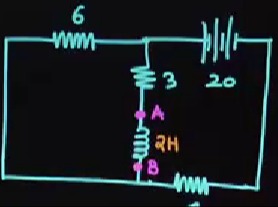Question
Question: The provided image depicts an electrical circuit diagram. However, the exact configuration and the q...
The provided image depicts an electrical circuit diagram. However, the exact configuration and the question being asked are not explicitly stated, leading to ambiguity. Based on common circuit problems and the visual cues, a likely interpretation is that the circuit is a Wheatstone bridge or a similar configuration, and the question is asking for the equivalent resistance between points A and B, or the potential difference between A and B, or the current through the 2 Ohm resistor.
Without a clear question, it is not possible to provide a definitive numerical answer. However, if we assume the question is asking for the equivalent resistance between points A and B, and assuming a standard circuit configuration where the battery is connected to the circuit, we need more information about the value of the resistor labeled 'Rx' and the exact connections.
If we assume the circuit is a balanced Wheatstone bridge, then the ratio of resistances in the arms would be equal. For example, if the battery is connected across the top and bottom wires, and the 6 Ohm and 3 Ohm resistors are in one branch, and the 2 Ohm and Rx resistors are in another branch, and A and B are the points between these branches, then for balance, 6/3=2/Rx, which implies Rx=3×(3/6)=1.5 Ohms. In a balanced bridge, the current through the galvanometer (or the element between A and B) is zero.
However, the diagram does not clearly indicate a balanced bridge, nor does it specify Rx. The drawing style is also ambiguous.
Given the lack of a specific question and the ambiguity in the circuit diagram, it is not possible to provide a concrete solution. The problem statement is incomplete.

The question is incomplete, and the circuit diagram is ambiguous. Therefore, no answer can be provided.
Solution
The provided image depicts an electrical circuit diagram. However, the exact configuration and the question being asked are not explicitly stated, leading to ambiguity. Based on common circuit problems and the visual cues, a likely interpretation is that the circuit is a Wheatstone bridge or a similar configuration, and the question is asking for the equivalent resistance between points A and B, or the potential difference between A and B, or the current through the 2 Ohm resistor.
Without a clear question, it is not possible to provide a definitive numerical answer. However, if we assume the question is asking for the equivalent resistance between points A and B, and assuming a standard circuit configuration where the battery is connected to the circuit, we need more information about the value of the resistor labeled 'Rx' and the exact connections.
If we assume the circuit is a balanced Wheatstone bridge, then the ratio of resistances in the arms would be equal. For example, if the battery is connected across the top and bottom wires, and the 6 Ohm and 3 Ohm resistors are in one branch, and the 2 Ohm and Rx resistors are in another branch, and A and B are the points between these branches, then for balance, 6/3=2/Rx, which implies Rx=3×(3/6)=1.5 Ohms. In a balanced bridge, the current through the galvanometer (or the element between A and B) is zero.
However, the diagram does not clearly indicate a balanced bridge, nor does it specify Rx. The drawing style is also ambiguous.
Given the lack of a specific question and the ambiguity in the circuit diagram, it is not possible to provide a concrete solution. The problem statement is incomplete.
